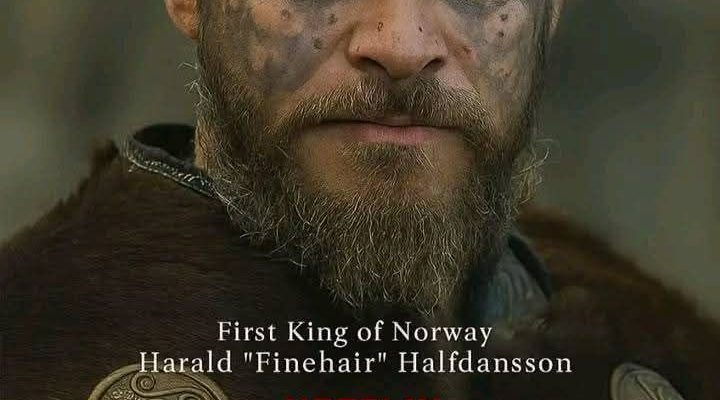The saga of Harald “Finehair” Halfdansson is one that echoes through the fjords and valleys of Norway, a story of ambition, unification, and the relentless pursuit of a crown that would bind scattered clans under a single banner. Born into a time of turmoil and fragmented kingdoms, Harald’s life was set against a backdrop of both opportunity and danger. The very soil of Norway, harsh and unyielding, seemed to demand strength and cunning from those who sought to shape its destiny. Harald was no ordinary man. From an early age, he displayed a fierce determination, a will tempered by both hardship and the whispering tales of his ancestors, men who had carved their names into the memory of the north through valor and cunning.
Harald was the son of Halfdan the Black, a petty king whose rule over portions of Vestfold had been marked by both diplomacy and war. Halfdan’s untimely death left young Harald in a precarious position. As a boy, he witnessed the precariousness of power: alliances could crumble in an instant, and blood could be spilled as easily in the mead hall as on the battlefield. It was this early exposure to the harsh realities of kingship that honed his mind, teaching him that leadership demanded both audacity and patience, and that a crown was rarely given freely. His sobriquet, “Finehair,” though seemingly trivial to the casual observer, carried with it weight and expectation. The hair he bore, long and flowing, was both a mark of nobility and a symbol of his destiny. It was said among his contemporaries that a king’s hair was a crown of its own, and Harald’s ambitious nature seemed reflected in the meticulous care with which he presented himself.
As Harald grew into manhood, Norway was not a single realm but a patchwork of petty kingdoms, each ruled by chieftains and kings whose loyalties were as shifting as the northern winds. These kings were bound more by blood and custom than by any formal law, and disputes over land, tribute, and honor were frequent and bloody. It was into this turbulent landscape that Harald stepped, armed with a vision of a unified Norway and the determination to see it realized. His early campaigns were as much about diplomacy as they were about warfare. Harald understood that brute force alone could not secure lasting allegiance. He married strategically, forging ties with powerful families, and he rewarded loyalty while ruthlessly punishing treachery.
The unification of Norway under Harald was neither swift nor simple. Many local rulers resisted his rise, clinging stubbornly to their autonomy. Battles were fought across fjords and forests, where the clash of axes and the thunder of shields echoed in valleys long silent. Harald proved himself a master of both strategy and intimidation. He employed alliances and cunning maneuvers as deftly as he wielded his sword. On occasion, he would feign retreat to lure opponents into traps, or negotiate peace treaties that bound rivals into mutual dependence. Every victory increased his reputation, and with each defeat of a rival chieftain, the idea of a single Norwegian kingdom moved closer to reality.
Yet Harald’s pursuit of unity was not solely a matter of conquest. It was also a matter of perception and legacy. He understood that to be king of all Norway, he needed not only the submission of other rulers but the recognition of the people. Harald traveled widely through his lands, presenting himself at assemblies, listening to grievances, and demonstrating both generosity and justice. His charisma and intelligence won over many who might otherwise have resisted his authority. Storytellers and skalds were employed to spread tales of his victories and wisdom, creating a narrative of inevitability around his reign. In doing so, Harald was as much a master of myth-making as he was of battle.
One of the most defining elements of Harald’s reign was his insistence that no man should remain king without showing the strength of his claim. According to legend, he declared that he would only be worthy of the title of king over all Norway if he had the hair long enough to cover it, a symbol of the unbroken lineage of kings and the greatness he aspired to. This seemingly trivial declaration was in fact a clever political maneuver, asserting both his authority and his commitment to the ideals of kingship. The act of growing his hair, and the attention to its care, became emblematic of his patience, discipline, and attention to the symbols of power.
Harald’s consolidation of power was not without personal cost. Rivalries, betrayals, and even familial strife marked his ascent. Many of the same families he sought to unite were forced into exile or annihilated when they resisted his rule. Harald’s life was punctuated by the deaths of rivals, the shifting of loyalties, and the delicate management of relationships that could tilt from friendship to enmity in an instant. Despite these challenges, he remained steadfast, guided by the vision of a Norway united under a single crown.
The crowning of Harald “Finehair” as the first king of a unified Norway was a momentous event, not only in his life but in the history of the region. It marked the end of an era dominated by fragmented rule and the beginning of a new order, one that would influence generations to come. Harald’s kingship was celebrated in song and story, his deeds immortalized by the skalds who traveled from fjord to fjord recounting tales of his courage, wisdom, and relentless ambition. His unification of Norway was more than a military achievement; it was a cultural and political revolution, forging a shared identity among people who had long been divided by geography and custom.
Despite his accomplishments, Harald’s reign was characterized by the same complexity that had defined his rise. His rule demanded constant vigilance, and the threats to his authority never entirely disappeared. Rebellions flared, rival chieftains plotted, and external forces sought to exploit any weakness. Yet Harald’s combination of strategic foresight, personal charisma, and martial prowess allowed him to navigate these challenges effectively. He was a king who understood that power was fragile and that legitimacy rested not only on conquest but on the perception of justice and strength.
Harald’s legacy extends beyond the mere unification of Norway. He established precedents for governance, succession, and the symbolic power of kingship that would shape the monarchy for centuries. The idea that a single ruler could command respect and allegiance across diverse regions became a defining principle of Norwegian identity. Harald’s life also inspired countless sagas and chronicles, ensuring that the lessons of his reign, both triumphs and failures, would be studied and remembered by those who came after him. His story is one of vision and determination, of the painstaking work required to turn ambition into lasting authority.
In recounting Harald “Finehair” Halfdansson’s life, one cannot ignore the human element that underpinned his achievements. He was a man driven by ambition, yes, but also by a desire to leave a mark on history. He was capable of great kindness and generosity, often rewarding loyalty and service with lands, titles, and honors. Yet he was also capable of ruthless action when circumstances demanded it, understanding that leadership in the north required both heart and steel. His personal attributes—his intelligence, discipline, and unwavering commitment—were inseparable from the larger narrative of his accomplishments.
The story of Harald is also a reminder of the interplay between myth and history. While the sagas immortalize him in larger-than-life terms, the reality of his reign was grounded in practical politics, strategy, and the management of relationships. The legend of “Finehair” served to reinforce his authority, creating a symbol around which people could rally. His careful cultivation of image, combined with his actual achievements on the battlefield and in governance, illustrates the timeless principle that power is both made and perceived.
By the end of his life, Harald had achieved what few could even imagine: the unification of Norway under a single crown. The crown was not merely a physical object but a representation of his vision, perseverance, and ability to navigate the complexities of leadership. The lands he ruled were no longer a fragmented tapestry of competing factions but a coherent kingdom with a shared identity, bound together by the authority of a single monarch. His death marked the conclusion of a transformative era, but the foundations he laid endured, shaping the course of Norwegian history for centuries.



